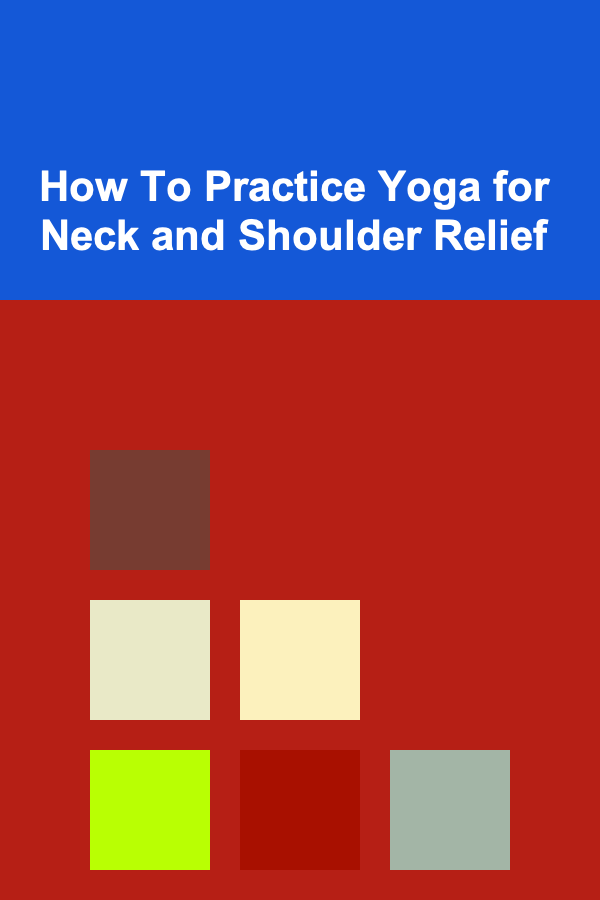
How To Practice Yoga for Neck and Shoulder Relief
ebook include PDF & Audio bundle (Micro Guide)
$12.99$5.99
Limited Time Offer! Order within the next:

Neck and shoulder pain are among the most common musculoskeletal complaints in the world today. With increasing screen time, sedentary lifestyles, and the growing prevalence of stress-related tension, it's no surprise that millions of people suffer from chronic neck and shoulder discomfort. One of the most effective and accessible methods for alleviating this type of pain is yoga. Yoga not only helps in strengthening and stretching the muscles but also encourages relaxation, mindfulness, and stress reduction. In this article, we will explore how to practice yoga specifically for neck and shoulder relief, offering step-by-step instructions for various poses, breathing techniques, and tips for incorporating yoga into your daily routine.
Understanding Neck and Shoulder Pain
Before diving into yoga practices, it's essential to understand the causes of neck and shoulder pain. Common reasons for discomfort in these areas include:
- Poor posture: Sitting hunched over desks or smartphones for prolonged periods can lead to muscle imbalances, tightness, and strain.
- Stress: Anxiety and stress often manifest as tension in the neck and shoulders.
- Injury or overuse: Strenuous activities or improper ergonomics during daily tasks can strain the muscles and lead to discomfort.
- Sedentary lifestyle: Lack of movement and exercise weakens muscles and makes them more susceptible to pain.
While there are many treatments for neck and shoulder pain, yoga offers a holistic approach that addresses the root causes by improving flexibility, strengthening muscles, and encouraging relaxation.
Benefits of Yoga for Neck and Shoulder Relief
Yoga has numerous benefits that can directly contribute to alleviating neck and shoulder discomfort:
- Improved flexibility: Yoga encourages stretching, which increases the range of motion in the neck and shoulders, reducing stiffness and tightness.
- Strengthening muscles: Regular practice strengthens the muscles supporting the neck and shoulders, helping to prevent future injuries.
- Posture correction: Yoga emphasizes body alignment, helping to improve posture and reduce the strain caused by poor alignment.
- Stress reduction: Many yoga practices, particularly those involving breathwork and mindfulness, help to reduce stress, which is a common trigger for tension in the neck and shoulders.
- Increased circulation: Yoga promotes better blood flow to the muscles, which aids in healing and recovery.
By incorporating yoga into your daily routine, you can experience long-term relief from neck and shoulder pain.
Preparing for Your Yoga Practice
Before beginning your yoga session, it's important to create a conducive environment for relaxation and focus. Follow these steps to prepare for your practice:
- Choose a quiet space: Find a calm, quiet area where you can practice without distractions.
- Use a comfortable mat: A yoga mat provides cushioning for your body and helps prevent slippage during poses.
- Wear comfortable clothing: Choose clothing that allows for full range of motion and flexibility.
- Set an intention: Take a few moments to set an intention for your practice, focusing on relief, relaxation, and mindfulness.
Breathing Techniques for Neck and Shoulder Relief
Breathing is a fundamental aspect of yoga that can significantly impact the effectiveness of your practice. Deep, mindful breathing activates the parasympathetic nervous system, which promotes relaxation and reduces muscle tension. For neck and shoulder relief, practice the following breathing techniques:
1. Diaphragmatic Breathing (Abdominal Breathing)
This deep breathing technique involves breathing deeply into your diaphragm rather than shallow chest breathing. It helps reduce tension in the neck and shoulders and encourages full relaxation.
How to practice:
- Sit or lie down in a comfortable position.
- Place one hand on your chest and the other on your abdomen.
- Inhale deeply through your nose, allowing your abdomen to rise as you fill your lungs with air.
- Exhale slowly through your mouth, allowing your abdomen to fall.
- Repeat for several minutes, focusing on the movement of your breath.
2. Ujjayi Breathing (Ocean's Breath)
Ujjayi breathing is often used in Vinyasa and Hatha yoga to create a calming, meditative state. The breath creates a slight constriction in the throat, producing a soft, ocean-like sound that encourages mindfulness and relaxation.
How to practice:
- Sit comfortably and close your eyes.
- Inhale deeply through your nose, and as you exhale, constrict the back of your throat slightly to create a soft hissing sound (similar to the sound of ocean waves).
- Keep your breathing steady and rhythmic.
- Continue for several minutes, focusing on the sound and sensation of your breath.
Both of these breathing techniques help to activate the body's relaxation response, which can alleviate stress and tension in the neck and shoulders.
Key Yoga Poses for Neck and Shoulder Relief
The following yoga poses specifically target the neck, shoulders, and upper back. These poses help stretch tight muscles, improve posture, and build strength, all of which can help alleviate discomfort.
1. Cat-Cow Pose (Marjaryasana-Bitilasana)
This dynamic movement between two poses helps increase flexibility in the spine, shoulders, and neck while stretching the muscles along the back.
How to practice:
- Begin on all fours, with your wrists under your shoulders and knees under your hips.
- Inhale as you drop your belly toward the mat, lifting your chest and tailbone (Cow Pose).
- Exhale as you round your back, tucking your chin to your chest and drawing your belly button toward your spine (Cat Pose).
- Repeat for 5-10 rounds, focusing on the movement of the spine and neck.
2. Thread the Needle Pose (Parsva Balasana)
This gentle twist stretches the shoulders, upper back, and neck, providing relief from tightness in the upper body.
How to practice:
- Start in a tabletop position (on your hands and knees).
- Inhale as you lift your right arm toward the ceiling, opening your chest.
- Exhale as you thread your right arm under your left arm, bringing your right shoulder and ear to the mat.
- Hold for 5-10 breaths, then slowly return to tabletop.
- Repeat on the other side.
3. Child's Pose (Balasana)
Child's Pose is a restful pose that gently stretches the shoulders, back, and neck. It also helps to relieve tension and promote relaxation.
How to practice:
- Start in a kneeling position, with your knees wide apart and your big toes touching.
- Exhale as you lower your torso to the mat, extending your arms forward.
- Rest your forehead on the mat, allowing your neck to relax.
- Stay here for 5-10 breaths, focusing on deep breathing and relaxation.
4. Eagle Arms (Garudasana Arms)
Eagle Arms stretch the shoulders and upper back, releasing tightness in the shoulder blades and neck.
How to practice:
- Sit or stand tall with your arms extended in front of you.
- Cross your right arm over your left arm at the elbow, bringing your palms to touch.
- If possible, wrap your forearms around each other and bring your hands toward your face.
- Hold for 5-10 breaths, feeling the stretch across the shoulders and upper back.
- Repeat on the other side.
5. Shoulder Bridge Pose (Setu Bandhasana)
This pose strengthens the glutes, lower back, and shoulders, while stretching the chest and neck.
How to practice:
- Lie on your back with your knees bent and feet flat on the mat, hip-width apart.
- Press your feet into the mat as you lift your hips toward the ceiling, keeping your shoulders on the floor.
- Interlace your fingers beneath your back and press your arms into the floor for stability.
- Hold for 5-10 breaths, then slowly lower your hips back to the mat.
6. Sphinx Pose (Salamba Bhujangasana)
Sphinx Pose is a gentle backbend that stretches the chest and shoulders while engaging the muscles of the lower back.
How to practice:
- Lie on your stomach with your forearms on the mat and elbows directly under your shoulders.
- Inhale as you gently lift your chest, engaging your back muscles and opening the chest.
- Keep your gaze forward or slightly upward, avoiding straining the neck.
- Hold for 5-10 breaths, then lower your chest back to the mat.
7. Neck Stretch (Seated)
This simple stretch targets the neck and upper back, relieving tension in the neck muscles.
How to practice:
- Sit in a comfortable cross-legged position or on a chair with your spine tall.
- Slowly tilt your right ear toward your right shoulder, keeping your left shoulder relaxed.
- Hold for 5-10 breaths, then repeat on the left side.
- To deepen the stretch, gently use your hand to apply light pressure to your head.
Tips for Preventing Neck and Shoulder Pain
In addition to regular yoga practice, it's essential to take a proactive approach to prevent neck and shoulder pain. Here are some tips for maintaining a healthy upper body:
- Maintain good posture: Be mindful of your posture throughout the day, especially when sitting at a desk or using a phone. Sit with your shoulders relaxed, spine upright, and head aligned with your body.
- Take frequent breaks: If you work at a desk, take regular breaks to stand, stretch, and move your body.
- Use ergonomic furniture: Invest in a supportive chair and adjust your desk setup to promote good posture.
- Strengthen your upper body: In addition to yoga, incorporate strength exercises that target the shoulders, upper back, and core to provide better support for the neck.
- Reduce stress: Practice mindfulness, meditation, or relaxation techniques to manage stress levels and prevent tension buildup in the neck and shoulders.
Conclusion
Yoga is a powerful tool for alleviating neck and shoulder pain, offering both immediate relief and long-term benefits. By incorporating the right poses, breathing techniques, and mindful practices into your routine, you can improve flexibility, strength, and posture, all while reducing stress and tension. Remember to listen to your body, progress at your own pace, and maintain consistency in your practice for the best results. With time, yoga can become a vital part of your wellness routine, helping you live a pain-free and balanced life.
Reading More From Our Other Websites
- [Home Cleaning 101] Best Eco‑Friendly Home Cleaning Routine for Families with Young Children
- [Organization Tip 101] How to Plan Meals for Your Trip to Save Money
- [Home Staging 101] How to Make Your Home Look Bigger and Brighter with Staging
- [Skydiving Tip 101] Fitness & Nutrition Tips to Boost Your Skydiving Performance
- [Reading Habit Tip 101] DIY Digital Libraries: Setting Up Your Own Budget E-Book Collection
- [Home Pet Care 101] How to Use Pet Technology for Better Care
- [Home Lighting 101] How to Use Task Lighting in Your Home for Better Functionality
- [Trail Running Tip 101] Top 10 Scenic Trail Running Routes to Explore Near You
- [Whitewater Rafting Tip 101] Paddling Toward Positivity: How Group Rafting Elevates Mental Well‑Being
- [Personal Investment 101] How to Build a Profitable AI Business with Deep Learning

Building Stronger Communities Together: Insights from a Successful Community Outreach Coordinator
Read More
How to Choose the Best Free Home Budget App for Your Needs
Read More
How to Organize Your Home for Better Energy Flow
Read More
How to Set the Ideal Rent Price for Your Rental Property
Read More
How to Design Book Covers That Sell
Read More
How to Meal Plan for Picky Eaters: A Checklist Approach
Read MoreOther Products

Building Stronger Communities Together: Insights from a Successful Community Outreach Coordinator
Read More
How to Choose the Best Free Home Budget App for Your Needs
Read More
How to Organize Your Home for Better Energy Flow
Read More
How to Set the Ideal Rent Price for Your Rental Property
Read More
How to Design Book Covers That Sell
Read More